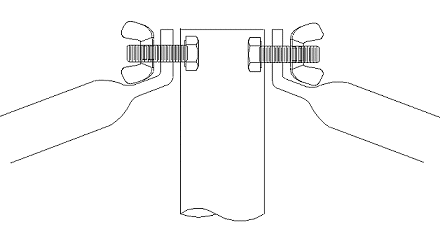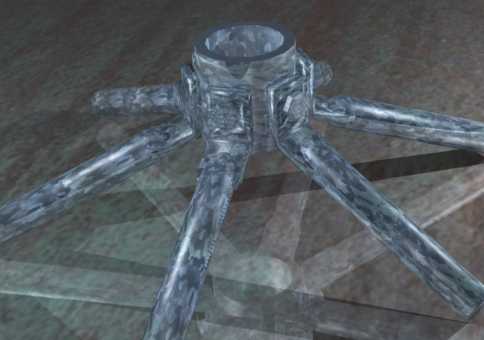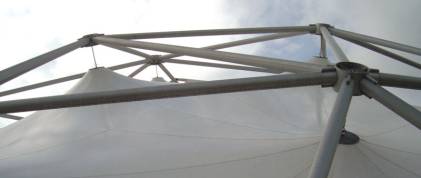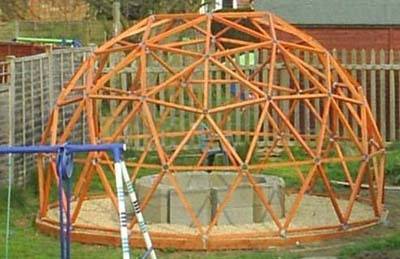
Tweet
| Navigation |
| Home |
| Site map |
| Articles |
| Contact |
| Links |
| Forum |



Dome building techniques – Tube & hub construction Making the struts This is very similar to the flattened conduit method except you’ll need to bend the ends just less than 90 degrees. There are other ways of connecting the struts to the hubs Making the hubs The hubs are real easy to make all you do is take some large diameter metal tube cut it into short lengths and drill the appropriate number of holes evenly around the side. The only thing you’ll need to be careful of is making sure the tube is big enough so you can get a spanner in to tighten the bolts when you come to assemble the dome. Building the frame. This method uses tubing with a flattened end like the flattened conduit method but instead of overlapping the ends a hub is used at each vertex. This has many advantages not least being able to take one strut out at a time. The only downside is that you’ll need five or six times as many nuts and bolts, what the heck bolts are cheap anyway. Construction tips. Make sure that the pipe used for the hub is of sufficient diameter to allow up to six connections and still get the spanner in to tighten the bolts. Use the Dome calculator to work out the strut length, remember that the calculator shows the vertex length, which is centre to centre of the hubs, so you will need to make allowances for hub diameter and bending the strut.  Covering the framework This system is great for making canvas domes. Cut and stitch a canvas dome slightly smaller than the framework then pull the canvas tight through the centre of each hub (see picture below)  This makes a very professional and tidy job and also shows off the framework, very cool… Conclusions: This is a nice easy way to build a dome only requiring slightly more work than the flattened tube method but gives a much more flexible and professional looking job. Use this method for building climbing frames, portable dome structures and even permanent large domes. Probably not suitable for dome homes or greenhouses (glass doesn’t like to be stretched) |
|
 |
|
| [ comments 21 ] |
| posted by Colin | 14/11/2006 11:11:31 |
 |
|
Hi Paul
A car bottle jack coupled with two steel channels and two 20mm threaded bars makes a good conduit squisher.
3" dia tube is a good size for hubs, use a socket on a ratchet for tightening the bolts. it`s much easier on the wrist ;)
Here`s my (soon to be recycled)14ft dia. hub & strut 3v dome. It`s made from timber though, not steel conduit. Very good example of a strut a hub dome, using a piece of pipe as the hub - Thanks for sharing your picture Colin. |
|
 |
|
| posted by Dennis | 29/11/2006 20:55:46 |
 |
|
|
Looking at the picture of Colin's dome, I am wondering how are the timber struts connected to the hubs? There wouldn't be enough space to connect from inside the tube surely? Colin sent this answer for you Dennis...Hi Dennis Perhaps the struts and hubs look thinner in the photo than they really are? The strut thickness dictates the minimum diameter of hub you can get away with using. You will need to be able to fit up to 6 struts around the tube perimeter comfortably. The struts are made from 2 inch x 1.5 inch timber and the hubs are 3" in diameter. To give some scale, each of the 20 concrete blocks in the dome photo are 18 inch x 9 inch x 9 inch The struts are connected to the hubs via M8 wood/metal dowels, which are basically a woodscrew thread on one end and a M8 machine thread on the other. They are screwed into pilot holes drilled into the strut ends so that just 15mm - 20mm of machine thread protrudes. Then it's a simple task of placing a washer and nut on the thread after inserting it into the hub and tightening it up with a 13mm socket. There's plenty of room inside the hub for the ratchet and socket. Hope this helps ;) |
|
 |
|
| posted by Alex | 26/05/2007 04:23:52 |
 |
|
| Thank You | |
 |
|
| posted by Alex | 10/06/2007 13:09:58 |
 |
|
| Thank You | |
 |
|
| posted by Graeme | 18/10/2007 06:52:33 |
 |
|
| Colin's dome looks wonderful! Are the ends of the struts angled where they attach to the hubs or is there a bit of "wide tolerance engineering" designed in? | |
 |
|
| posted by Colin | 19/10/2007 01:35:52 |
 |
|
| Hi Graeme, Thanks for the flowers, do you plan to build one? With some planning you should be able to transform a huge pile of uncut timber into a finished dome frame in a couple of days. The struts have the usual angles cut at the ends. You can cut a vee or use a sanding drum to profile a nice curved end too.. but only if you`re a perfectionist :) The old timber dome in the pic has now ceased to exist but a lot of the timber has been recycled into my latest "one of a kind" dome project.. nothing goes to waste here :) | |
 |
|
| posted by Graeme | 24/10/2007 09:35:19 |
 |
|
| Yes, I plan on building one, I just need to work out the cost of materials (I'll probably go with a 2v to keep the cost down). Perfectionist I ain't, so flat ends on to the hub will be fine :) I just need to decide on a hub material, are the hubs in the one above steel pipe? I'm not sure what will be available locally, but I'm sure I'll find something suitable. | |
 |
|
| posted by Colin | 27/10/2007 17:49:27 |
 |
|
| The material for the hubs will depend on the size of the dome and the timber size itself. The timber size will dictate the minimum diameter for the tube as you`ll need to fit upto 6 struts to it. Large diameter tubes are weaker, relatively speaking, than small diameter so the wall thickness may need to be increased. The hubs transfer loads, support the weight of the dome and any additional loading (cover materials, snow etc). Bear in mind the bottom hubs will ultimately carry a lot more weight than the hubs at the top. Schedule 40 pvc would be ok for a small dome upto around 20ft dia, schedule 80 pvc, aluminium and steel is better for large domes. Lots of pro`s and cons to weigh up.. cost, strength and longevity. Aluminium doesn`t rust but is pricey, steel is very strong but rusts and is a lot more difficult to cut and drill, Pvc is reasonably cheap, easy to machine but has less strength. Decisions decisions :) | |
 |
|
| posted by Paul | 23/11/2007 20:36:07 |
 |
|
| I'd like to see the construction of the hub on the suspended canvas dome, looks like a good option with a low profile for covering from the outside with less stress on the canvas. Thanks! | |
 |
|
| posted by Nathan | 27/04/2008 01:27:30 |
 |
|
| Collin, could you send me a close up picture of the hub or tell me how you figured out where to drill the holes? | |
 |
|
| posted by colin | 28/04/2008 00:51:23 |
 |
|
| Hi Nathan The information is on the "Make your own 3v geodesic dome hubs" thread. Drill the tubular hubs as per the diagrams in a clock face fashion. You can use wood-to-metal dowels or coach screws to fix the strut ends to the hubs. Wood to metal dowels are more expensive but allow you to repeatedly dismantle the dome which might be a useful feature for some :) | |
 |
|
| posted by josh | 27/12/2008 16:13:39 |
 |
|
| Hello Colin Referring to your idea from 2006. Hi Paul, A car bottle jack coupled with two steel channels and two 20mm threaded bars makes a good conduit squisher. I have the jack , but I dont have a clear idea what the steel channels and threaded bars would form. Could you give me more details or a picture? Thanks | |
 |
|
| posted by Dan | 21/02/2010 04:23:42 |
 |
|
| Collin, I want to make a 3v type 12 to 16 feet in diameter... the one you built looks really nice,,, can you ask how you made it? are there any books that have diagrams etc? | |
 |
|
| posted by rai | 10/04/2010 11:45:11 |
 |
|
| when using hubs does one have to adjust the length of there struts? say i'm constructing an 18 foot dome, and my lengths are 3.14' 3. 63' and 3.71' do i keep the same lengths with or without a hub? i think that i do.. also, what are peoples thoughts of paneling with cardboard and layering with fiberglass for a semi-permanent structure maybe lasting up to a year? probably going with plywood struts, haven't decided yet though, all very tentative at this point.. also still considering using ply for panels. i'm basically looking to construct a moderately cheap structure that is habitable for an extended period of time | |
 |
|
| posted by Lizzie James | 27/03/2011 17:40:19 |
 |
|
| i am looking for a plan of how to build a dome and where to buy the tubular parts and hubs etc.....we need it for a climbing/sitting in exercise dome for our playfield...Can you guiode me in the right direction?thanx Lizzie James in Lampeter Wales | |
 |
|
| posted by gary | 08/01/2012 23:00:54 |
 |
|
| brillant collin , my hat off to you. i made one 16 ft dia 3v -using uv rated plastic conduit 25mm for green house and covered with 5mm Polycarbonate panel,twin-wall. but im gonna make a wood one as they have personality | |
 |
|
| posted by Buddy | 20/09/2012 06:42:41 |
 |
|
| I have 61 6 inch pvc hubs 4 inch wide. Will the degre of lines on hub be 72 for the red 60 for the green and 62 and 58 on the mix | |
 |
|
comments will be accessed through the forum in the new site design (coming soon)
9142
Copyright © 2007- 2014 geo-dome.co.uk. All Rights Reserved.